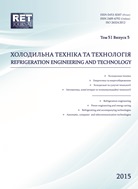CONCEPT AND MODEL OF MESOSCOPIC POROSITY FOR THIN PERMEABLE MEDIA
DOI:
https://doi.org/10.15673/0453-8307.5/2015.44797Keywords:
standard porosity, hydrophilic and hydrophobic media, effective porosity, alternate basic model of permeable media.Abstract
There are two main obstacles to perform the objective comparison and choice of preferable variant within the set of appropriate textile materials (TM), related to the thin permeable media: 1) the different experimental methodologies and tools usable by different authors for an estimate of water-vapor-transmission rate; 2) the different ambient conditions of such measurements and a variety of experimental means proposed, at present, for an estimate of TM-porosity. Recently we have studied, in detail, the former factor [V.B.Rogankov et al, Refrigeration Engineering and Technologies, 51(1), 2015, pp.47-54] and pointed out the possible strategy to overcome this obstacle. In this work we will pay the main attention to the latter factor. The novel concept of mesoscopic (nano-) porosity of threads is formulated for any woven and non-woven TMS. The resulting alternate basic (AB-) model for theoretical estimate of effective (observable) porosity in hydrophilic and hydrophobic permeable media is developed. It is based, exclusively, on the standard (but the measuring-laboratory-condition’s-dependent) measurements of so-called square mass and thickness for the wide set of 41 samples taken from 5 different experimental works. The proposed treatment of such data leads to the simple, well-founded relationships of AB-model without any adjustable coefficients. They provide a possibility to obtain the reliable estimates for the following fundamental TM-characteristics: density of moist and/or dry matrix; observable effective porosity at any level of ambient moisture; maximum hygroscopicity without the additional experiments.References
A.V. Medvedeva, D.M. Mordasov, M.M. Mordasov. Classification of Methods of Control of Porous Ma-terials. Transactions TSTU 2012. v.18. № 3, pp.749-753.
M.Yu,Treschalin, V.S.Mandron, G. K. Mukha-medzhanov. Investigation of capillary lifting of liquid in non-woven materials.. Izvestiya Vuzov. Technology of the textile industry. – 2009, №4С, с.24-26.
M.Boguslawska-Baczek, L.Hes, Effective Water Vapor Permeability of Wet Wool Fabric and Blended Fabrics, Fibres & Textiles in Eastern Europe, 2013, 21, 1(97): 67-71.
M.I.Drozd, T.F.Martsinkevich, M.N.Mikhalko. Es-timation of steam permeability of knitted underwear fabrics. vestnik.vstu.by›eng/issues/vestnik-23-2012, №23, p.34.
S.X.Wang, Y.Li, H.Tokura, J.Y.Hu, Y.X.Han, Y.L.Kwok, R.W.Au. Effect of Moisture Management on Functional Performance of Cold Protective Clothing. Text.Res.J., 2007, 77(12). 968-980.
J.Huang, X.Qian. Comparison of Test Methods for Measuring Water Vapor Permeability of Fabrics, Text.Res.J., 2008, 78(4). 312-352.
A.S.Iberall, Permeability of Glass Wool and Other Highly Porous Media, Rep. Bur. Aeronautics, Navy Depart., Washington, DC, USA, 398-406.


